- Know all about Lakhudiyas Caves in Almora, Kumaon and see lovely pictures.
Studying Indian Art & Architecture is always fascinating and exuberating in knowledge. Much so, the rock arts–ancient, human-made markings/ paintings made on the natural stone that have stood the test of harsh weather conditions for over 10,000 years. While we have preserved some of the most beautiful Art and Architecture from the Medieval and Modern Periods the significance of Prehistoric art has been
perpetually overlooked.
It is imperative to highlight to the current and future generation that India has some of the world’s richest repositories of stoneage sites like Bhimbetka Shelters
and Cave Paintings (Madhya Pradesh), Attirampakkam
(Tamil Nadu), Belan
Valley (Uttar Pradesh), and others. These places tell intriguing and
perplexing stories of human evolution.
Let us discuss one of the impressive pieces of evidence of those times in
detail - Lakhudiyar
Caves. Located in the Barechhina village at the banks of the Suyal River in the Almora District of Uttarakhand, a Himalayan state in India, this paleolithic site presents artistic activities of the distant past. Lakhudiyar literally translates to one lakh caves.
But for those who have experienced the site, it could fall short of such an
elaborative definition.
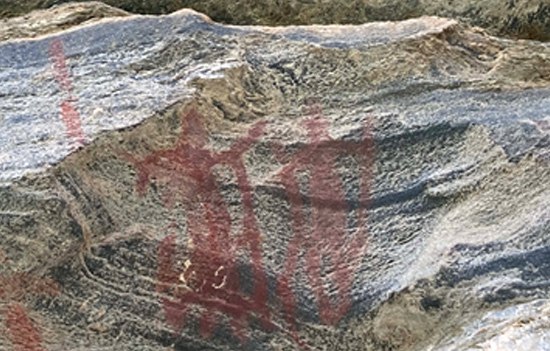 Cave Painting depicts Hunter-Gatherer, probably, on their way to collect wild plants & Hunt Wild Animals
Cave Painting depicts Hunter-Gatherer, probably, on their way to collect wild plants & Hunt Wild Animals
Paleolithic means “Old Stone Age”, a Greek term coined by archaeologist John Lubbock in 1865. It is a period in human prehistory distinguished by the original development of stone tools. During this time, early humans hunted, camped, and adorned the walls with images of their world. It is believed that the Paleolithic humans painted, drew,
engraved, or carved for aesthetic reasons or to represent the beauty they
inhabited. While some believe it to have sacred components, designed by the men
to orchestrate their cultural and religious beliefs.
And
the trail to Lakhudiyar begins
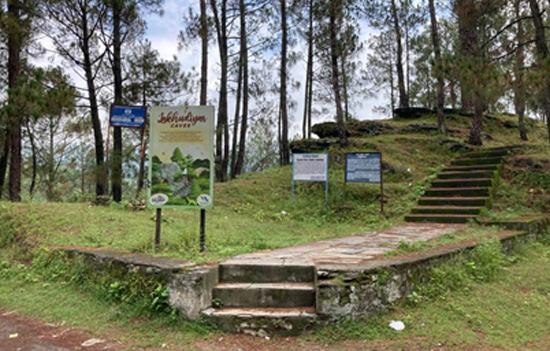 Main Entrance to the Site.
Main Entrance to the Site.
The site is endowed with rich resources like fresh river water, pine trees, and is connected via National Highway 309 A that passes through the three districts namely Pithoragarh, Bageshwar, Almora in the state’s Kumaon region. It is thus easily accessible and likely to attract visitors.
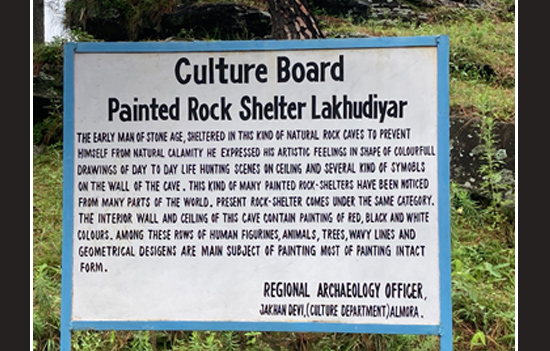 Culture Board at site.
Culture Board at site.
The
journey to the caves starts with bi-lingual Cultural boards (in Hindi and
English) describing the life of the early man of the Stone Age. He sheltered in
these natural caves to protect himself from natural calamity and harsh climate.
Further, he expressed his artistic feelings in the shape of colourful drawings
of day to day life hunting scenes in red, black and white.
The Journey to Tranquility
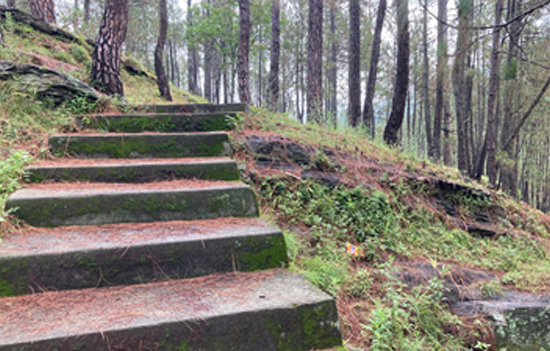 Steps leading up to the Cave.
Steps leading up to the Cave.
The place
is quiet, without any shops or cafeterias to ignite a spark of interest or
intrigue the visitors. That said, for those who are curious enough to learn
about the bygone era and its art, the recently constructed steps amid Chir/Pine evergreen trees may offer
a feeling of walking through an enchanting space just like the feeling one gets
while walking around Jageshwar
Temple, also close to Almora.
The trek to the caves in itself is not an uphill task. It is under five minutes
from the main road. And as one climbs up, they can see the spring-fed river
Suyal and hear its sound, possibly leaving them bewildered with several
questions, especially the one about the first settlement of men during the
Paleolithic era.
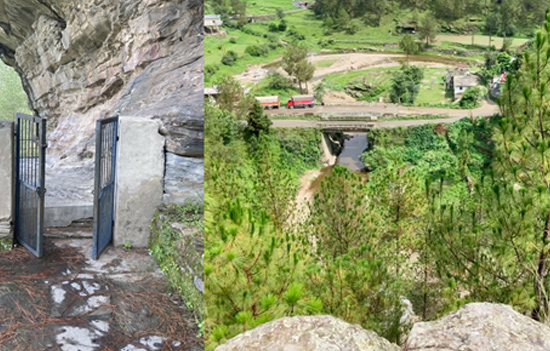 A small gate to Cave (L), Eagle View of Suyal river.
A small gate to Cave (L), Eagle View of Suyal river.
As one
enters through the gate, it becomes apparent that there are no caves but a
vertical cliff face that depicts the life of the early men through remnants of
art. As per Wikipedia, on one side of the wall is a painting of people,
stick-like forms, performing a mass dance in a group of thirty-four. What is
left unreported is a few animal motifs, one of them closely resembling a fox.
Wavy lines, rectangle-filled geometric designs and groups of dots are seen
here. These paintings provide one of the richest experiences of Prehistoric art
in the country.
Nevertheless, such a close observation depicting primitive lifestyle is
possible with the presence of a historian or an archaeologist by your side.
![]()
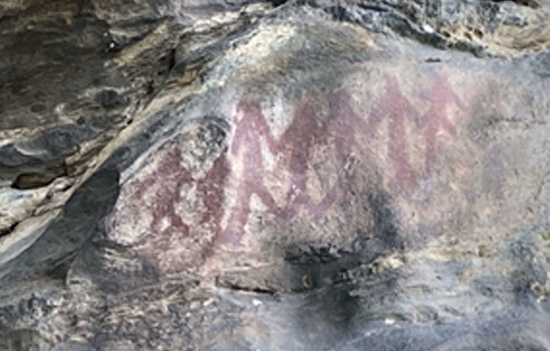 Hand-linked dancing figures.
Hand-linked dancing figures.
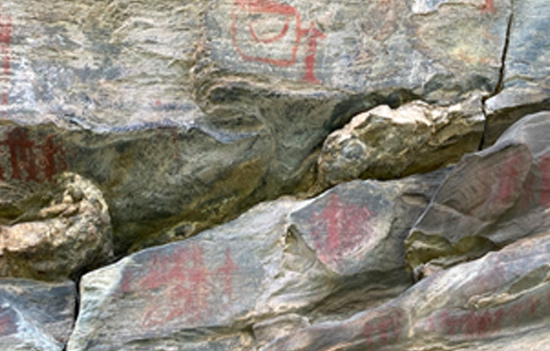 Rectangle-filled Geometric signs.
Rectangle-filled Geometric signs.
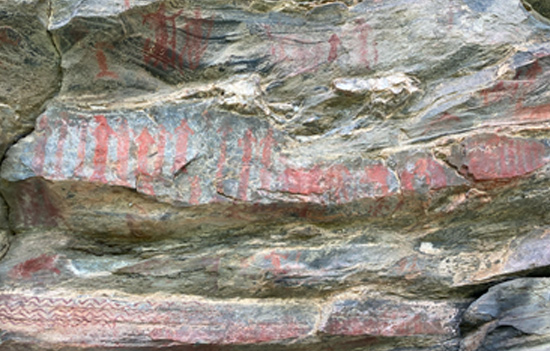 Arrows (top), Wavy Lines (bottom).
Arrows (top), Wavy Lines (bottom).
Many
Questions Left Unanswered
This is it! It’s just one big painted rock shelter that encapsulates paintings drawn with fingers, majorly in red along with a few traces of white.
Despite that, the tranquility reverberating throughout the location overtook
the mixed reaction felt during this experience. This was once the rescue spot
of early men to save themselves from the harsh climate.
This was once home to some of the earliest men on our planet. They experienced life when there was no paper or language and even if there was one, it’s unlikely to get deciphered. They chose the Suyal river as their base and took sanctuary in the nearby caves. Finding the right place to live in must have been difficult as they were up against the other living beings or the unknowns like mammoth, tiger etc.
Their needs were limited to food, water and shelter. When these basic needs
were fulfilled, they expressed themselves using the cave walls as their canvas.
Most of the time, they drew sketches of what they encountered. Surprisingly and
fortunately a lot of it has stayed intact.
Lakhudiyar is more than just a case study, it’s also an expression. An expression that if we don’t start to conserve our historic sites, we are denying future generations an opportunity to see something remarkable. “If you don’t know where you’ve come from, you don’t know where you’re going.” says Maya Angelou, a famous American Poet.
There is
still some time left before the colour on these walls vanishes. If not
preserved future generations will never know the goodness and artistry of the
people from the bygone era.
Author is a Pahadi from the state of Uttarakhand. All pictures by author.
References
1.https://www.drishtiias.com/to-the-points/paper1/rock-art-part-1
2.https://ncert.nic.in/ncerts/l/kefa101.pdf
3.https://en.wikipedia.org/wiki/Lakhudiyar_Caves
4. https://almora.nic.in/flora-and-fauna/
5. https://en.wikipedia.org/wiki/Paleolithic
6.https://study.com/academy/lesson/the-stone-age-in-india-history-culture-tools.html
To see numerous albums on two regions of
the state
1. Garwhal
2. Kumaon
3. Travelogue
Kumaon with album links